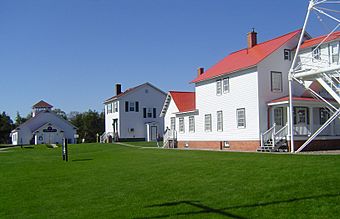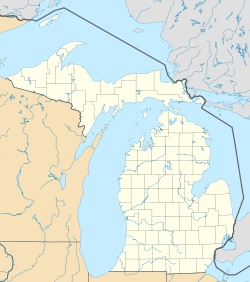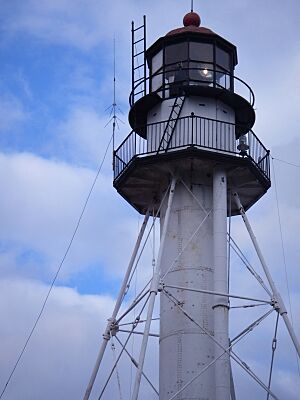Great Lakes Shipwreck Museum facts for kids
|
Great Lakes Shipwreck Museum
|
|

Great Lakes Shipwreck Museum complex
|
|
| Location | Whitefish Point Light |
|---|---|
| Nearest city | Shelldrake, Michigan |
| Area | 8.27 acres (3.35 ha) |
| Built | 1985 |
| Architectural style | Iron pile lighthouse |
| NRHP reference No. | 73000947 |
Quick facts for kids Significant dates |
|
| Added to NRHP | February 28, 1973 |
The Great Lakes Shipwreck Museum is a special place where you can learn about shipwrecks and brave rescues on the Great Lakes. It's located at the Whitefish Point Light Station in Chippewa County, about 11 miles (18 km) north of Paradise, Michigan.
This museum is run by the Great Lakes Shipwreck Historical Society (GLSHS). They share the Whitefish Point site with the Michigan Audubon Society (MAS) and the United States Fish and Wildlife Service (USFWS). The museum shows amazing items from shipwrecks found in the Whitefish Point Underwater Preserve. One of its most famous exhibits is the bell from the SS Edmund Fitzgerald, a ship that sank in 1975. When you visit, you can also explore old buildings that tell stories about maritime history, the United States Coast Guard, and the US Life-Saving Service.
Contents
History of the Museum Site
Early Days at Whitefish Point
Whitefish Point has been important for ships for a long time. A lighthouse has guided ships here since 1848. The United States Coast Guard (USCG) had people working at Whitefish Point until 1971. That's when the lighthouse equipment became automatic. In 1973, the Whitefish Point light, which is the oldest active light on Lake Superior, was added to the National Register of Historic Places. This means it's a very important historical site.
Groups Protecting Whitefish Point
In 1976, the Michigan Audubon Society (MAS) started studying migrating birds at Whitefish Point. They formed the Whitefish Point Bird Observatory (WPBO) in 1978 to keep an eye on these birds.
The Great Lakes Shipwreck Historical Society (GLSHS) was also started in 1978 by a group of divers. Their goal is to help people understand and appreciate the history of ships on the Great Lakes. In 1983, the GLSHS got permission from the Coast Guard to open a museum at the Whitefish Point Light Station. The museum first opened its doors in 1985.
Working Together for the Land
Over the years, different groups worked to decide how to best use and protect the Whitefish Point area. In 1992, a plan was made by Whitefish Township, the MAS, the Michigan Department of Natural Resources (DNR), the GLSHS, and the USCG. This plan aimed to protect the special environment of the light station.
There were some discussions about artifacts (old items) from shipwrecks. In 1993, the state of Michigan and the GLSHS agreed that the museum could display these artifacts.
The Edmund Fitzgerald Bell
One of the most famous items at the museum is the bell from the SS Edmund Fitzgerald. This ship sank in 1975, and the bell was brought up from the wreck on July 4, 1995. It became a central part of the museum, honoring the crew members lost on the Fitzgerald and all sailors who have been lost at sea. There was a discussion about whether the bell should travel for exhibitions, but the museum decided to keep it at Whitefish Point after families of the crew members shared their feelings.
Transferring the Land
In 1996, a law was passed that allowed the Coast Guard to transfer the Whitefish Point Lighthouse property to the different groups. The GLSHS received about 8.27 acres (3.35 ha) to continue telling the story of maritime history. The WPBO received 2.69 acres (1.09 ha) for bird research. The USFWS received 33 acres (13 ha) to manage as part of the Seney National Wildlife Refuge, which is a protected area for wildlife. This transfer meant that each group had to take care of their part of the land and protect its history and natural beauty.
Planning for the Future
After the land transfer, the groups worked together to create a plan for how Whitefish Point would be used and developed. This plan, called the Human Use/Natural Resource Management Plan, was finalized in 2002. It helps make sure that any new buildings or changes are done carefully, protecting the natural and historic parts of Whitefish Point. The GLSHS, MAS, and USFWS now work together on a committee to manage the area.
Exploring the Museum Complex
Since 1984, the GLSHS has worked hard to restore and improve the historic buildings at Whitefish Point Light Station. These buildings help tell the stories of Great Lakes maritime history, the USCG, and the US Life-Saving Service. When you visit, you can tour many of these buildings with your museum admission.
Modern Buildings
- Museum: The main museum building opened in 1985. It's the second largest building at Whitefish Point. Here, you'll find amazing artifacts from local shipwrecks, including the famous bell from the SS Edmund Fitzgerald. The museum also displays items from other shipwrecks in the Whitefish Point Underwater Preserve, like the Comet, John B. Cowle, Drake, Samuel Mather, Miztec, Myron, Niagara, John M. Osborn, Sagamore, Superior City, and Vienna.
- Gift Shop and Offices: This is the largest building at Whitefish Point, built in 1999. The main floor is a gift shop where you can find souvenirs. The lower level has public restrooms, and the upper level holds the museum's offices.
Historic Buildings
- Light Tower:
The first light tower was built in 1848 from stone. It used whale oil to create its light! But Lake Superior's storms were too strong for it. So, in 1861, a new steel tower was built by order of President Lincoln. The light has had different lenses over the years. In 2011, a modern light-emitting diode (LED) lantern was installed. The lighthouse became automatic in 1971, but it still helps guide ships today. Visitors can't go inside the light tower itself, but you can tour the lightkeeper's home next door.
- Fog Signal Building: This brick building was built in 1937 after an earlier one was destroyed in a storm. It used to house equipment that made loud fog signals to warn ships in bad weather. The Coast Guard stopped using fog signals from Whitefish Point in 1995. Today, the GLSHS uses this building for maintenance.
- Lookout Tower: This tower was built in 1923 for people to watch for ships 24 hours a day during shipping season. The GLSHS moved and restored it in 1998. It is not open to the public.
- Lightkeeper's Quarters: This two-story house was built in 1861 for the lightkeeper and his family. Later, it was changed into a duplex to house both the main lightkeeper and an assistant. It was restored in 1996 to look like it did in the 1920s. You can tour this building with your museum admission.
- Assistant U.S. Coast Guard Chief's Quarters: Built in 1925, this two-story house was for the light station's Chief and his family. The museum used to display shipwreck artifacts here before the main museum building was constructed in 1987.
- Crews Quarters: This two-story building was moved several times to protect it from shore erosion. The GLSHS bought it in 1990 and moved it back to the site. It's currently being renovated and is not open to the public.
- Surfboat House:
This building was restored in 2001. Inside, you can see a full-size replica of a Beebe-McClellan 26 feet (7.9 m) surfboat. It also has exhibits about the U.S. Life-Saving Service and Coast Guard rescue stations, which are part of the museum tour.
- Frame Storage Building: The Coast Guard built this for storing firewood. The GLSHS used it as a gift shop until the new, larger gift shop building was built in 2006.
- Chief's Garage: This 3-car garage was built in 1940. Today, the Whitefish Point Bird Observatory uses it as a lab for bird banding and as a base for educational tours.
- Other Historic Structures: There's also an 1861 steel lamp oil house and a 1910 alcohol house. These buildings were used to store fuel for the light before it became electric in 1931.
Other Cool Things at Whitefish Point
Whitefish Point is a popular spot for many activities. People love to watch ships, observe birds, and collect rocks here.
- Whitefish Point Unit of Seney National Wildlife Refuge: The USFWS manages about 33 acres (13 ha) of land here as part of the Seney National Wildlife Refuge. This area is important for many animals and plants. It's especially vital for the piping plover, a small shorebird. In 2009, piping plovers started nesting at Whitefish Point again after many years! The land here is unique, with wooded dunes and many different kinds of plants and trees.
- Whitefish Point Bird Observatory: This group works with the Michigan Audubon Society. They study migrating birds at Whitefish Point. Because of their work, Whitefish Point is known as a Globally Important Bird Area for birds.
Where to Find the Museum
The Great Lakes Shipwreck Museum is located at the very end of Whitefish Point Road. It's about 11 miles (18 km) north of Paradise, Michigan, in the northeastern part of Michigan's Upper Peninsula. It sits right where Whitefish Point Road ends and Whitefish Bay meets Lake Superior.
See also
- Great Lakes Storm of 1913
- List of Great Lakes museum and historic ships






